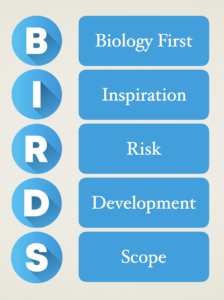How do you solve problems?
I am an engineer, academic, and consultant. As a Bio-inspired Design (BID) practice and pedagogy researcher, I lead students, industry professionals and organizations through the process of taking inspiration from nature to solve problems.
Scroll down to learn about BID and my approach.
Use the menu bar above to learn more about my research and consulting, as well as resources for your next BID project.
Biomimicry is an interdisciplinary field at the intersection of the life sciences, physical sciences, and engineering, and it is leading to an ever deeper understanding of how biological systems work. It is the process of studying nature to solve human problems. It also has other names, including biomimetics, bio-inspired design and nature inspired innovation. In all of these, the focus is not on what can be extracted from the natural world (that is called bio-utilization) or looking like nature (that is called bio-morphism), but what can be learned from nature. I, like most of the engineering community, have adopted the terminology of Bio-inspired Design (BID) in my work.
Bio-inspired design is an interdisciplinary design practice that involves learning about the physical and non-physical characteristics of biological systems, which leads to the discovery of unconventional solutions to problems that are often more efficient, economic and elegant.
What makes this practice powerful and innovative is that it challenges convention. BID requires thinking about the problem and applying resources differently.
The successful practice of bio-inspired design hinges on having the proper mindset. A mindset is a particular way of thinking, and can orient an individual’s attitudes or expectations. For example, the growth mindset by Carol Dweck, Ph.D. which orients people to thinking they can grow, learn from failure, and be successful at new things. I have developed a mindset for practicing BID and created the acronym B.I.R.D.S. to help remember it.

Biology First – It is absolutely essential to learn about biology when practicing bio-inspired design. This means reading about things or looking at diagrams in terminology that may not make sense initially. Without a basic understanding, the biological context is missed or misunderstood. Use curiosity to learn more about biology so the connections back to the problem can become clear.
Inspiration – The goal in practicing bio-inspired design is to arrive at a solution that is inspired by nature; rather than imitating it. To move beyond a solution that looks like the biological system requires learning a mix of physical (things we can see) and non-physical (things we cannot see) information about the biological system. Use the seven analogies categories (called inspiration categories in my TEDx talk) to sort through biological information. Then that biological information needs to be generalized in order to make it accessible to the problem. Use abstractions, text or visual, to help with generalizing the biological information.
Risk – Practicing bio-inspired design involves intellectual activity with a high uncertainty of the outcome. The result of the effort could be a failure or lead to an innovative solution. Either way, it most often requires an iterative approach as well as understanding that there is no “right” biological inspiration. Well studied biological systems are good to start with as they have the most information available. Look for scientific/engineering principles in the biological systems to manage the uncertainty.
Development – Although practicing bio-inspired design might seem different because of the incorporation of biological information, it is a process similar to other design processes. Therefore it has similar product or process development phases and tasks. Expecting bio-inspired design to be a way to by-pass part of the development process or be a faster way to innovation will lead to disappointment. Expecting to be challenged to use existing resources in new and interesting ways is a better outlook.
Scope – Problem scoping drastically impacts the result when practicing bio-inspired design. The vast amount of biological information can quickly become overwhelming if the size and type of problem is not well defined. It is important to recognize that not all aspects of a solution have to be bio-inspired to be successful, and generally sub-systems are a better place to start. Use re-framing to find more relevant biological systems for solving the problem.
The BID Canvas can help structure this mindset and develop good habits when practicing bio-inspired design.
This mindset can be cultivated through developing a set of skills: curiosity, abstraction, recognizing the difference between inspiration and imitation, identifying scientific/engineering principles in biology, and re-framing. These are the skills that I teach in my BID course and professional trainings.
Furthermore, developing a mindset for bio-inspired design assists with overcoming common pitfalls when practicing bio-inspired design:
- Using the wrong language to express the problem
- Endlessly searching for a perfect match
- Assuming the solution must look like the biological inspiration
- Getting lost in the process of bio-inspired design
To keep learning about the practice of BID, view this page next – Bio-inspired Design.